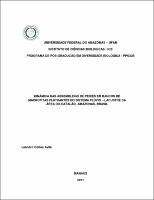| ???jsp.display-item.social.title??? |


|
Please use this identifier to cite or link to this item:
https://tede.ufam.edu.br/handle/tede/3618| ???metadata.dc.type???: | Dissertação |
| Title: | Dinâmica das assembléias de peixes em bancos de macrofitas flutuantes do sistema flúvio lacustre da área do Catalão, Amazonas, Brasil |
| ???metadata.dc.creator???: | Avila, Leandro Cortes  |
| ???metadata.dc.contributor.advisor1???: | Buhrnheim, Cristina Motta |
| First advisor-co: | Deus, Claudia Pereira de |
| ???metadata.dc.description.resumo???: | Nas planícies de inundação da região amazônica, uma grande porção das assembléias de peixes utiliza os bancos de macrófitas aquáticas como área de alimentação, reprodução, refúgio, berçário, e como meio dispersor. A intensidade e a variação do nível das águas influenciam consideravelmente na composição, riqueza e abundância das espécies em certas localidades. Foram analisados dados das assembléias de peixes de bancos de macrófitas da ilha do Xiborena durante os anos 2003-2007 com o intuito de compreender como as assembléias respondem às variações hidrológicas em escalas temporais inter e intra-anuais. Durante estes cinco anos foram capturados 40.302 exemplares de peixes de 197 espécies, sendo que os Characiformes compreenderam 51,77% dos indivíduos com 102 espécies. A biomassa total foi 58,37 kg, com os Characiformes representando 61,89% deste total. A espécie mais abundante foi Moenkhausia lepidura com 8.735 indivíduos e a espécie com maior biomassa foi Schizodon fasciatus (6,26 kg). Houve diferença significativa quanto à riqueza de espécies entre os períodos de águas altas (179 spp.) e águas baixas (131 spp.), porém as composições não foram significativamente diferentes (p= 0,16). Os valores de abundância total entre águas altas e baixas indicaram diferenças significativas (15.740 e 24.562 indivíduos respectivamente) (p= 0,0049) (variação intra-anual). Os valores de biomassa total no período de águas baixas foram maiores (29,6 kg) do que no período de águas altas (28,7 kg). A taxa de substituição de espécies (Turnover) foi alta, a composição das assembléias de peixes mudou especialmente entre os anos 2004 e 2005. Quanto à estabilidade, as assembléias de peixes na ilha do Xiborena foram altamente variáveis (coeficiente de variação= 78,01 %). A persistência das assembléias durante os cinco anos de estudos, medida pelo valor W de Kendall, corrobora esta observação as assembléias sofreram variações ao longo dos anos. As assembléias de peixes da ilha do Xiborena são fortemente influenciadas pelo pulso de inundação, que apesar de ser um evento cíclico também está sob efeito de eventos estocásticos, tais como secas e/ou cheias mais pronunciadas, influenciando-as de maneira não previsível. |
| Abstract: | In the Amazon floodplain a large proportion of fish assemblages use aquatic macrophytes as an area for feeding, reproduction, refuge, breeding and as a mean of dispersion. The intensity and variation of the water level considerably influenced the composition, richness and abundance of the species at certain localities. Analyzed data show the dynamic of the macrophyte fish assemblages from the Xiborena island during the years of 2003-2007, with the aim of comprehending how the fish assemblages respond to the hydrological variations in temporal scales, within and between years. During these five years 40,302 fish were captured of 197 species, with the Characiformes accounting for 51.77% of the individuals with 102 species. Total biomass was of 58.37 kg, being the Characiformes responsible for 61.89% of this amount. The most common species was Moenkhausia lepidura with 8,735 individuals and the species with higher biomass was Schizodon fasciatus (6.26 kg). There was significant difference between species richness between the high water (179 spp.) and the low water periods (131 spp.), however the composition as not significantly different (p= 0.16). The total abundance values between high and low water periods indicated significant differences (15,740 and 24,562 individuals respectively) (p= 0.0049) (within year variation). The total biomass values in the low water period were higher (29.6 kg) when compared with the high water period (28.7 kg). Species turnover was high, species composition changed especially between 2004 and 2005. Related to stability the fish assemblages were highly variable in the Xiborena island (coefficient of variation = 78.01%). The assemblage persistence during the five years of study (measured by Kendall's W) corroborates this observation – the assemblage experienced variations among the years. Xiborena island fish assemblages are highly influenced by the flood pulse, which despite being a periodic event is also under influence of stochastic events (such as more pronounced dry or wet periods), affecting the fish assemblages in an unpredictable way. |
| Keywords: | Assembléias de peixes Macrófitas aquáticas Catalão - Amazonas Fish assemblages, macrophytes Substituição de espécies Peixes - Pulso de inundação |
| ???metadata.dc.subject.cnpq???: | CIÊNCIAS BIOLÓGICAS |
| Language: | por |
| ???metadata.dc.publisher.country???: | BR |
| Publisher: | Universidade Federal do Amazonas |
| ???metadata.dc.publisher.initials???: | UFAM |
| ???metadata.dc.publisher.department???: | Instituto de Ciências Biológicas |
| ???metadata.dc.publisher.program???: | Programa de Pós-graduação em Sociologia |
| Citation: | AVILA, Leandro Cortes. Dinâmica das assembléias de peixes em bancos de macrofitas flutuantes do sistema flúvio lacustre da área do Catalão, Amazonas, Brasil. 2011. 54 f. Dissertação (Mestrado em Diversidade Biológica) - Universidade Federal do Amazonas, Manaus, 2011. |
| ???metadata.dc.rights???: | Acesso Aberto |
| URI: | http://tede.ufam.edu.br/handle/tede/3618 |
| Issue Date: | 30-Mar-2011 |
| Appears in Collections: | Mestrado em Diversidade Biológica |
Files in This Item:
| File | Description | Size | Format | |
|---|---|---|---|---|
| Leandro Cortes Avila.pdf | Dissertação | 1.13 MB | Adobe PDF |  Download/Open Preview |
Items in DSpace are protected by copyright, with all rights reserved, unless otherwise indicated.




